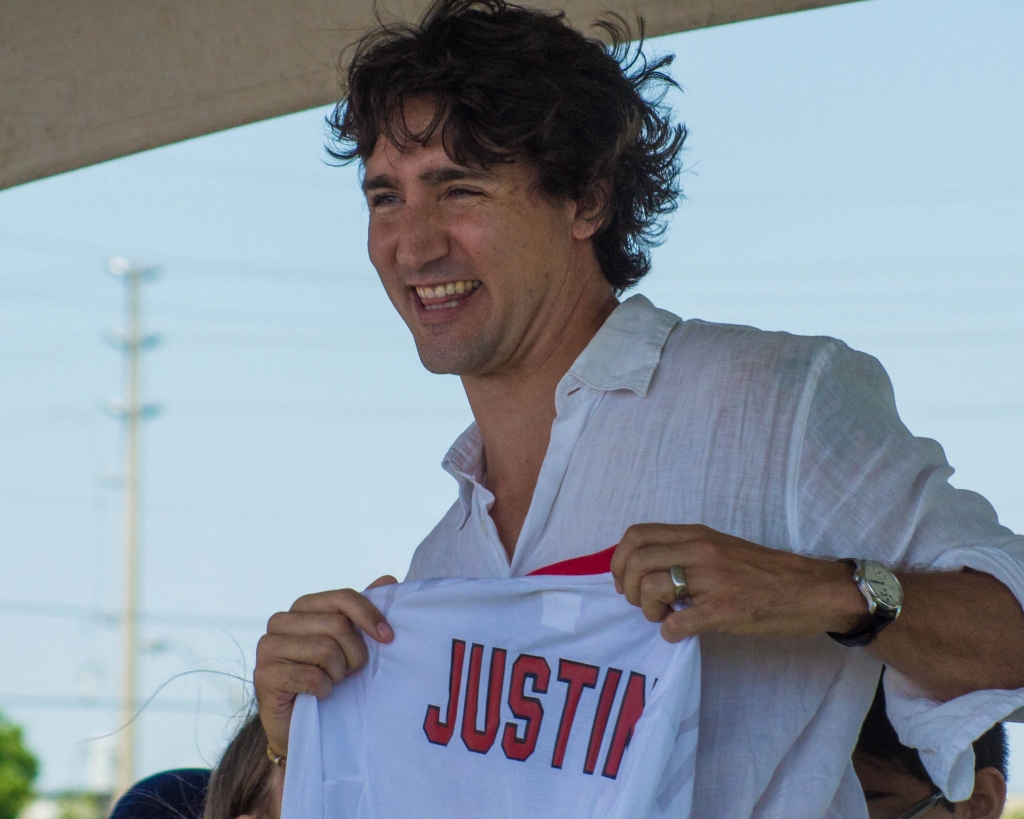 British politicians have a long history of looking across the Atlantic for policy and campaign ideas. Since Justin Trudeau’s landslide election victory in October 2015, however, Canada has begun to displace the US as the focus of progressive admiration. Yet direct comparisons may not be very insightful, explains Peter Sloman.
British politicians have a long history of looking across the Atlantic for policy and campaign ideas. Since Justin Trudeau’s landslide election victory in October 2015, however, Canada has begun to displace the US as the focus of progressive admiration. Yet direct comparisons may not be very insightful, explains Peter Sloman.
Labour politicians wonder how the 43-year-old Trudeau managed to deflect heavy Conservative attacks on his fitness for office and win support for a massive CDN$125 billion package of infrastructure investment, partly financed by government borrowing. At the same time, Liberal Democrats marvel at the way the Canadian Liberals recovered from their worst ever defeat in the 2011 election – taking third place with just 34 out of 308 seats – to form a majority government in 2015.
The Labour MP Jon Ashworth has now set out a number of lessons for the British left in a very useful pamphlet for Policy Network, based partly on conversations with Canadian Liberal strategists. Ashworth is right to argue that there is much to be learned from Trudeau’s optimistic campaign style, appeal to young voters, and effective use of data analytics, but it’s also important to recognize just how different the landscape of Canadian politics is. In particular, Trudeau and his party had three major advantages which Labour and the Liberal Democrats do not share.
Firstly, the Canadian Liberals have long been the ‘natural party of government’ in Canada – in power for 63 of the last hundred years, compared with 34 for British Labour. The party has always been a ‘big tent’ organisation, committed to integrating Canada across cultural and linguistic lines – and never more so than under the leadership of Trudeau’s father Pierre, prime minister 1968-79 and 1980-4, who introduced official policies of bilingualism and multiculturalism, championed a strong federal government in the face of rising Quebec separatism, and patriated the constitution. Pierre Trudeau’s policies were not always popular – indeed, they eventually alienated much of francophone Quebec and western Canada – but they did allow the Liberals to dominate the centre ground of Canadian politics and wrap themselves in the flag.
More recently, Jean Chrétien and Paul Martin’s government of 1993-2006 became famous for its tough zero-based spending review, which turned a deficit of 9 per cent of GDP into a surplus in just three years and was much studied by George Osborne and other British policy-makers after the 2008 financial crash. The Liberals’ resulting reputation for economic competence made it much easier for them to advocate deficit spending in 2015, as the collapse in oil prices hit Alberta hard and pushed Canada into recession. The contrast with the Labour Party’s historic problem of economic credibility could hardly be greater.
Secondly, Justin Trudeau’s embrace of activist government made sense because there was a large pool of votes to be won on the Liberals’ left. The Liberals’ steady loss of support between 1993 and 2011 was only partly driven by defections to Stephen Harper’s Conservative Party, whose vote share was only a little higher than its two predecessor parties had secured in the 1990s. More important was the growing appeal of the trade union-backed New Democratic Party, which exploited left-wing discontent with Chrétien’s cuts, campaigned for more investment in public health and education, and displaced the Liberals as the official opposition in 2011. Trudeau’s support for stimulus spending, improved child benefits, and a higher top rate of tax allowed him to outflank the NDP on the left and signal a break with the cautious Liberal governments of the past. Again, it’s not clear what Jeremy Corbyn or Owen Smith can learn from this. Even if SNP and Green voters switched en bloc to Labour, the party would still be a long way short of a majority.
Thirdly, the Canadian Liberals’ dramatic advance from 34 to 184 seats under Trudeau is partly a reflection of Canada’s unusual electoral volatility. In three of the last eight federal elections (1993, 2011 and 2015) more than 30 per cent of seats have changed hands – a rate of turnover not seen in the UK since 1945. Class has never been as important in Canadian politics as in western Europe, and the rather different party systems which operate at provincial level – notably in Quebec and British Columbia – tend to inhibit the development of partisanship. Here too the contrast is striking. Although the British electorate has been undergoing dealignment for almost half a century, the Liberal Democrats and UKIP have struggled to turn large increases in vote share into seats in Parliament, and Labour and the Conservatives continue to dominate politics in most of England and Wales. Indeed, the number of marginal seats has declined in recent years as a result of regional polarization.
None of this means that Trudeau’s victory should not be closely studied. From a British perspective, his success in mobilizing historically low-turnout groups such as young people and First Nations is particularly striking. But if the main lesson is that a charismatic centre-left leader fighting a tired Conservative government can achieve a kind of electoral alchemy, British politicians might reasonably say that they already know that.
The real question is whether a leader elected on a modernizing platform can hold their coalition together whilst living up to their supporters’ hopes of radical social and political change. As Nick Pearce has pointed out, the early signs suggest that Trudeau is adopting a rather Blairite governing style, geared towards ‘delivery’ and ‘outcomes’, though without the neurotic attention to press and focus group reactions that so often hamstrung New Labour. The new government’s decision to budget for five years of deficits – two more than the Liberals promised in the election – is a particularly risky experiment. In the end, it is likely to be the success of this stimulus package in returning Canada to growth that will make or break Trudeau’s reputation.
 Peter Sloman is University Lecturer in British Politics at the University of Cambridge. He tweets as @pjsloman.
Peter Sloman is University Lecturer in British Politics at the University of Cambridge. He tweets as @pjsloman.









One thing that cannot be understated with Trudeau’s victory is the near instantaneous flare up of Western Separatist sentiment in Canada, particularly in Alberta.
One thing to understand about Canada is secession movements define Canadian politics and Canadian Federal Politics are entirely about keeping the nation together.
The Harper Conservatives capitalized on Western separatist sentiment, particularly in Alberta, from the 1990’s to propel themselves to power. The previous Liberal governments gained (and lost) power over their handling of the Quebec Separatist movements.
The greatest challenge Trudeau will face in his term is keeping Alberta from separating.
As an Alberta separatist myself, I do not plan on making it easy for him.
Among Albertans, support is growing and particularly in light of the growing movement in Europe for secession referendum (Brexit, Scotland, Spain, Italy, etc.) the idea is gaining a lot of traction.
It is hard to use Trudeau’s victory as a model, since the election result was completely unpredictable, and relied upon a perfect storm of circumstances. The biggest being the inability of the NDP to repeat last election’s success, particularly in the riding-rich province of Quebec. Although I am a social liberal and despised Stephen Harper’s ideological and anti-science governance, I am also a fiscal conservative, so I have doubts about the deficit model of spending. Like many countries, Canada is stuck with a system where there are only 2-3 parties along the traditional left/right spectrum, which doesn’t provide much choice for voters who lean left on social issues, but right on economic issues. I was appalled that Stephen Harper was re-elected last round. Still, I suppose the Canadian system is already more flexible than the rigid 2-party system in the US, where change is so difficult to achieve even with a supposed progressive President like Obama.
Canada’s aging. It is suffering from resource curse (which Harper also exemplified) ;and has small economy. That is why 40% of immigrants leave in 10 years. I personally know several immigrants who were shocked by the limited job prospects. After one loses a job;hard to find another job even if you were employed in top notch companies-as a friend in KPMG and aunt employed by Ortho Pharmaceuticals for decades revealed to me.
Canada needs to take page out of Germany’s support of SME’s via the Fraunhofer-Gesellschaft. UK shockingly didn’t learn this despite years on EU!
Article by a Canadian:
https://hbr.org/2014/05/why-germany-dominates-the-u-s-in-innovation/
Why Germany Dominates the U.S. in Innovation
“Germany has found a way to create jobs through maintaining manufacturing competitiveness.”
http://business.time.com/2011/02/25/does-germany-know-the-secret-to-creating-jobs/
Does Germany know the secret to creating jobs?
Doesn’t hurt that we are a LIBERAL society ! We like our social programs. We like our liberal ways…we are pro choice, pro pot, pro same sex marriage…we are FOR more than we are AGAINST. We are for physician assisted suicide…there are many things Trudeau is championing that most of us want ! So far so good !! It is clear other commenters are cons and Harper wannabe’s…
Justin’s a raging globalist, and while media outlets across the nation attempt contact for commentary on said issues, he’s busy delivering the Shahada at one of our many Megamosques….Shirtless, of course…..SUNNI ways, indeed!
Did you write this article before our latest economic report came out? Our unemployment has gone up by a full tenth of a percent and business community is not gaining investments. Our import/export ratio has gone up as well. All Trudeau has done is increased our debt by $115bn over the next five years. There was also that MP he elbowed while grabbing another. His very first act of parliament was to repeal bill C-15, which forced unions to report to members how their dues were spent and made secret ballot voting mandatory. He plans to change the way we vote into the Liberals favour without a referendum, even though polls show that over 70% of Canadians want one.
But the best part of your article is this “though without the neurotic attention to press”. Trudeau never saw a camera he didn’t like and our state broadcaster is sure to report on every feel-good story they can about him. Our economy is tanking, yet the media is enraptured with the shirtless photos of him popping up everywhere. The liberals are the media party.